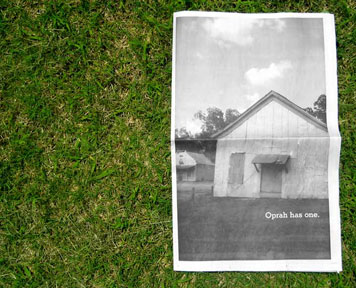


Project M, Buy A Meter Project, 2007.
During the recent Live Earth Concerts for A Climate in Crisis, I was struck by the tension between the initiative's global aspirations and the small, personal lifestyle changes suggested during every intermission — use electronic bill paying to save paper and mail, buy CFL bulbs, turn showers off while you soap up. It's the old "Think Globally, Act Locally" maxim applied to a huge media event.
Project M works on the "act locally" level. This innovative summer design camp was created by John Bielenberg in 2003 and was inspired by Samuel Mockbee, who founded The Rural Studio for Architecture in Alabama and won the MacArthur Prize for his work. Every year Project M brings together 8-10 young designers for an intensive design experience: the designers have to conceive and develop their own project. To date, projects have included work in Costa Rica and Ghana, an expedition to deliver donated supplies to Katrina victims, creating new parks on abandoned urban lots in East Baltimore, and, now, the Buy A Meter project in Hale County, Alabama.

Project M, Buy A Meter project newspaper, 2007.
Hale County was the home of Mockbee's Rural Studio, so Buy A Meter is a fitting fifth anniversary initiative for Project M. Working with Pam Dorr, who gave up a career at The Gap to work with the rural poor, eight students created this project and a newspaper to announce the initiative. (If you want to be inspired, watch the video interview with Pam Dorr on the project's blog.)
The facts are simple: one in four families in Hale County are not connected to the municipal water system. Without this service, these families often get water contaminated with sewage. It costs $425 to bring clean water to a single home. It is clear that in the last decade, the rural poor in America have gotten poorer. But having safe water is not something most of us think of as a problem in our country. Let alone a design problem.


Comments [5]
"Yes, the air car is real."
Perhaps John Bielenberg's summer design camp Project M should take the air car under its wing and design a commercial for it with Bob Dylan.
Yes, 'n' how many times can a man turn his head,
Pretending he just doesn't see?
The answer, my friend, is blowin' in the wind,
The answer is blowin' in the wind.
07.28.07
09:48
07.29.07
03:50
Everyone can do their part... to bring awareness to a campaign on a local level, directly involving people in THEIR community does more than these LIVE-Anything concerts.
Good post.
07.30.07
03:32
07.31.07
10:23
08.25.07
04:43